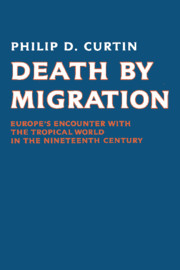Book contents
- Frontmatter
- Contents
- List of Tables, Figures, and Maps
- Preface
- List of Abbreviations
- 1 The Mortality Revolution and the Tropical World: Relocation Costs in the Early Nineteenth Century
- 2 Sanitation and Tropical Hygiene at Midcentury
- 3 Killing Diseases of the Tropical World
- 4 Relocation Costs in the Late Nineteenth Century
- 5 The Revolution in Hygiene and Tropical Medicine
- 6 The Pursuit of Disease, 1870–1914
- Conclusion
- Appendix Statistical Tables
- Bibliography
- Index
1 - The Mortality Revolution and the Tropical World: Relocation Costs in the Early Nineteenth Century
Published online by Cambridge University Press: 29 March 2010
- Frontmatter
- Contents
- List of Tables, Figures, and Maps
- Preface
- List of Abbreviations
- 1 The Mortality Revolution and the Tropical World: Relocation Costs in the Early Nineteenth Century
- 2 Sanitation and Tropical Hygiene at Midcentury
- 3 Killing Diseases of the Tropical World
- 4 Relocation Costs in the Late Nineteenth Century
- 5 The Revolution in Hygiene and Tropical Medicine
- 6 The Pursuit of Disease, 1870–1914
- Conclusion
- Appendix Statistical Tables
- Bibliography
- Index
Summary
Between the seventeenth century and the middle of the twentieth, the Western world passed through a profound demographic change. Earlier patterns of high mortality and high fertility gave way to comparatively lower birth and death rates, like those that prevail today. The crucial change is generally (but not universally) interpreted as a “mortality revolution” – a one-time and dramatic change in death rates that opened the possibility for lower birth rates as well. By the mid twentieth century, the mortality revolution had reached most world societies. Not all of them chose lower fertility, but those that failed to do so experienced runaway population growth, sometimes as high as 4 percent per year.
In the nineteenth century, death rates not only dropped in Europe; they dropped even more dramatically among Europeans who went overseas. The change profoundly altered Europe's epidemiological relationship to the rest of the world. In the eighteenth century and before, death rates of Europeans moving into the tropical world at least doubled and could increase several fold – even for men in the prime of life. When these death rates began to drop, Europeans were free to move into the tropical world at far less risk than ever before.
The Statistical Base
Military doctors have given us our best records of death and disease among mobile populations – and death from disease was far more serious in the nineteenth century than death in battle. Military doctors often treated men recruited in one part of the world and serving in another. From the early nineteenth century, they became especially concerned about recording what they observed.
- Type
- Chapter
- Information
- Death by MigrationEurope's Encounter with the Tropical World in the Nineteenth Century, pp. 1 - 39Publisher: Cambridge University PressPrint publication year: 1989



